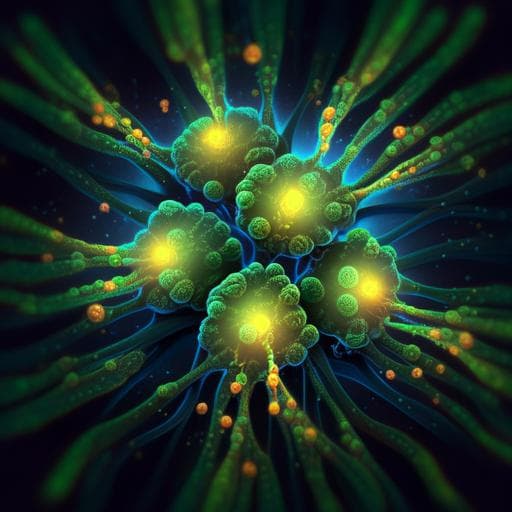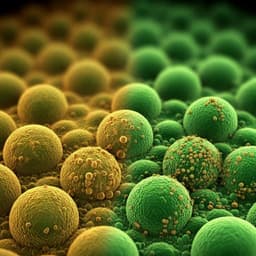
Agriculture
A giant NLR gene confers broad-spectrum resistance to Phytophthora sojae in soybean
W. Wang, L. Chen, et al.
Discover the exciting breakthrough in soybean disease resistance! This study identifies the *Rps11* gene as a powerful weapon against *P. sojae*-caused phytophthora root and stem rot. The research conducted by a team of experts reveals significant genetic diversity in this critical defense mechanism, showcasing the dynamic evolution of NLR genes.
~3 min • Beginner • English
Introduction
Phytophthora is a genus of plant-damaging oomycetes with over 170 species, many of which are significant plant pathogens (e.g., Phytophthora infestans and Phytophthora sojae). Phytophthora diseases are difficult to control chemically; thus deploying resistant varieties is an effective and environmentally friendly strategy. In soybean, dozens of resistance-to-P. sojae (Rps) loci/alleles have been mapped to genomic regions enriched with NLR genes, but many have become ineffective to newly evolved isolates and few have been isolated or functionally validated, complicating breeding and pyramiding efforts. The study aims to identify and clone a gene conferring broad-spectrum resistance to P. sojae and to elucidate its genomic context and evolutionary history. The authors report that Rps11 provides broad-spectrum resistance, is a large NLR arising from unequal recombination, and resides in a highly labile NLR cluster exhibiting extensive structural diversification.
Literature Review
Prior work mapped multiple Rps loci to NLR-rich genomic regions in soybean; however, effectiveness of many loci has diminished against new P. sojae races and few loci have been cloned or functionally verified. Previous reports attributed resistance at the Rps1-k locus to small NLR genes in Williams 82, though these genes are not found in current Williams 82 assemblies, leaving their candidacy unresolved. Comparative studies in other crops (maize Rp1, sorghum Pc) highlight that NLR clusters often evolve through unequal recombination leading to structural and copy number variation, influencing resistance specificity and durability. Species-wide NLR inventories (e.g., Arabidopsis pan-NLRome) and diverse genome assemblies (e.g., maize) reveal pervasive NLR cluster plasticity, motivating detailed, gap-free analyses of specific resistance loci such as Rps11.
Methodology
Plant materials and resistance evaluation: Mapping populations derived from a cross between PI 594527 (resistant) and Williams (susceptible) were used. From 17,050 F1 plants (from heterozygous F2), 43 recombinants were identified between boundary markers SSR286 and SSR320. About 30 seedlings per line were inoculated with P. sojae race 1 using hypocotyl inoculation; lines were classified as susceptible (<25% survival), segregating (25–75%), or resistant (>75%). Additional evaluations used F5 RILs (Rps11/Rps11) against 158 P. sojae isolates collected across Indiana.
Genotyping: SSR and Indel markers were designed from resequencing data of parents; only uniquely mapping markers in the Rps11 region were used. A dominant donor-specific marker (Marker_176kb) and competitive allele-specific PCR markers assisted fine mapping.
Genome sequencing and assembly: PI 594527 was sequenced using PacBio Sequel (8 SMRT cells, 77× coverage; subread N50 28.9 kb), Bionano Saphyr optical maps (molecule N50 441 kb; 267×), and 10x Genomics Chromium linked reads (45.2×; mean molecule length 93.8 kb). Raw reads were corrected and assembled with Canu v1.8 (custom parameters), polished with pbmm2 and Arrow, then further corrected with Pilon v1.22 using Chromium reads. Bionano maps were assembled (Solve3.2.2) and used for hybrid scaffolding (Solve3.3) with manual conflict resolution, yielding 43 hybrid scaffolds (N50 26.4 Mb; total 978.1 Mb) and 229 unscaffolded contigs (21.3 Mb). Pseudomolecules were constructed by aligning scaffold chunks (100 bp) to the Wm82.a2.v1 reference using minimap2 v2.10 to determine order/orientation.
NLR annotation and expression: NLR genes were annotated with NLR-Annotator. RNA-seq (new and public) was mapped to the donor genome using STAR v2.7.9a; expression was quantified by read counts per NLR. qRT-PCR used a soybean ATP-binding cassette transporter (Consf) as endogenous control. 5′-RACE (GeneRacer kit) was performed with nested PCR to identify transcription start regions (TSRs) for NLRs (R1, R4, R6, R9, R12); reads containing 5′-ends were mapped to the genome. TSR presence/absence across accessions was assessed by BLASTing the R6 TSR against 20 kb upstream of each NLR.
Phylogenetics and comparative genomics: Phylogenetic trees (Minimum Evolution in MEGA7) used NB-ARC domains or combined NB-ARC/LRR regions where appropriate. Dot plots and synteny analyses elucidated duplication events and structural variation in the Rps11 region. NLR copy number and structural variation were assessed across high-quality genome assemblies of 28 additional soybean accessions (pan-genome), annotating 296 NLRs corresponding to the Rps11 region.
Transformation and complementation: The R6 coding sequence (CDS) was synthesized (in three fragments) and assembled with the AtUbi3 promoter into a Gateway entry vector, then recombined into a destination vector for Ochrobactrum-mediated transformation of soybean cultivar 93Y21. Transformed embryonic axis explants underwent selection and regeneration; Cre-lox heat-shock treatment removed selectable markers. Transgenic lines (homozygous T2 families) and controls were inoculated with P. sojae races 25, 31, and OH12108-06-03. Transgene presence was confirmed by PCR; expression was quantified by qPCR.
Key Findings
1. Rps11 confers broad-spectrum resistance to P. sojae: F2:3 families (14 Rps11/Rps11 vs. 14 rps11/rps11) showed perfect genotype–phenotype associations across 14 races. F5 RILs (Rps11/Rps11) resisted 127 of 158 field isolates (80%) collected across Indiana.
2. Fine mapping and candidate identification: Using 17,050 F1 plants and 43 recombinants between SSR286 and SSR320, the locus was narrowed to a 151 kb region containing four NLRs (R5, R6, R7, R8). RNA-seq showed only R6 expressed in inoculated and control stems; R6 expression perfectly correlated with resistance in recombinants, identifying R6 as Rps11.
3. Gene architecture: Rps11 spans ~27.7 kb from TSR to TTS; the CDS is 7392 bp encoding a 2463-aa NLR. The TSR is ~13.1 kb upstream of the ATG; the region between TSR and ATG contains three large and one small introns and yields a ~560 bp 5′-UTR.
4. Functional validation: Transgenic 93Y21 lines harboring pAtUbi3::CDS-Rps11 were resistant to P. sojae races 25, 31, and OH12108-06-03, comparable to an Rps11/Rps11 F5 RIL. Survival rate improvements were statistically significant (e.g., P = 5.75 × 10⁻8; 2.71 × 10⁻6; 1.83 × 10⁻4). Transgene expression was detected; expression levels were lower than in the Rps11/Rps11 RIL (e.g., P = 3.33 × 10⁻11; 9.68 × 10⁻6; 9.15 × 10⁻6) and correlated with resistance, indicating no autoimmunity due to overexpression.
5. Evolution and structural variation: The Rps11 region in PI 594527 harbors 12 NLR genes (R1–R12), many enlarged by LRR tandem duplications; only one allelic pair (R8–r7) exists between PI 594527 and Williams 82 v3.0. Across 28 additional soybean genomes (30 accessions total), NLR copy number in the corresponding region ranges from 5 to 23, influenced by unequal recombination, segmental duplications/deletions, and inversions. Rps11 lacks allelic copies in other accessions. The ~13.1 kb TSR-ATG region of Rps11 likely formed via promoter fusion from sequences upstream of two adjacent NLRs (e.g., W05.r5 and W05.r6). Presence of a conserved TSR is associated with higher NLR expression (TSR+ vs. TSR−; P = 3.3 × 10⁻10).
Discussion
The study addresses the challenge of durable resistance to P. sojae by identifying and validating Rps11, a giant NLR that confers broad-spectrum resistance and can be introgressed into elite cultivars. Expression-guided fine mapping, enabled by gap-free assemblies of both donor and reference genomes, was critical in a structurally labile NLR cluster. The gene’s unusual architecture—extensive LRR expansions and a long 5′ region with multiple introns—likely reflects an evolutionary trajectory shaped by unequal recombination and segmental duplication, potentially underpinning broader effector recognition. Pan-genomic analysis underscores the dynamic and idiosyncratic evolution of NLR clusters, explaining the absence of allelic Rps11 in other accessions and highlighting the necessity of population-scale structural genomics for resistance gene discovery. The successful complementation demonstrates practical utility, while the association between TSR presence and NLR expression suggests promoter-level mechanisms influencing resistance deployment and stability.
Conclusion
Rps11 was isolated as a 27.7 kb NLR gene whose expression confers broad-spectrum resistance to Phytophthora sojae. Through extensive fine mapping, expression analyses, transformation-based complementation, and comparative genomics across a soybean pan-genome, the work elucidates the origin, structural dynamics, and functional consequences of a highly expanded NLR cluster. The findings provide robust molecular markers and a validated gene for breeding strategies aimed at sustainable soybean protection. Future research should dissect how LRR domain expansion shapes effector recognition breadth, clarify how 5′-UTR introns modulate expression and immunity, define the native promoter architecture underpinning tissue-specific and inducible expression, and evaluate Rps11’s efficacy across broader environmental contexts and pathogen populations. Rational engineering or editing of NLRs inspired by Rps11’s architecture may further enhance disease resistance.
Limitations
The transgenic complementation used the AtUbi3 promoter and not the native promoter; boundaries of the native promoter and full regulatory architecture remain unresolved. While Rps11 showed broad resistance, the exact mechanisms conferring breadth—particularly the role of expanded LRRs—were not experimentally dissected. The functional impact of large 5′-UTR introns on expression and immunity remains unknown. Many tested field isolates lacked race-type characterization, limiting detailed spectrum analysis. The absence of allelic Rps11 in other accessions complicates direct allelic comparisons and may affect generalizability across diverse genetic backgrounds.
Related Publications
Explore these studies to deepen your understanding of the subject.







